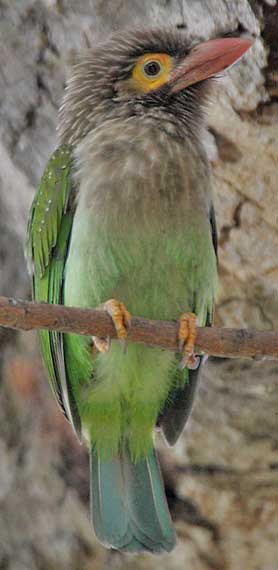
Psilopogon zeylanicus (*)
Superregnum: Eukaryota
Cladus: Unikonta
Cladus: Opisthokonta
Cladus: Holozoa
Regnum: Animalia
Subregnum: Eumetazoa
Cladus: Bilateria
Cladus: Nephrozoa
Superphylum: Deuterostomia
Phylum: Chordata
Subphylum: Vertebrata
Infraphylum: Gnathostomata
Megaclassis: Osteichthyes
Cladus: Sarcopterygii
Cladus: Rhipidistia
Cladus: Tetrapodomorpha
Cladus: Eotetrapodiformes
Cladus: Elpistostegalia
Superclassis: Tetrapoda
Cladus: Reptiliomorpha
Cladus: Amniota
Classis: Reptilia
Cladus: Eureptilia
Cladus: Romeriida
Subclassis: Diapsida
Cladus: Sauria
Infraclassis: Archosauromorpha
Cladus: Crurotarsi
Divisio: Archosauria
Cladus: Avemetatarsalia
Cladus: Ornithodira
Subtaxon: Dinosauromorpha
Cladus: Dinosauriformes
Cladus: Dracohors
Cladus: Dinosauria
Cladus: Saurischia
Cladus: Eusaurischia
Subordo: Theropoda
Cladus: Neotheropoda
Cladus: Averostra
Cladus: Tetanurae
Cladus: Avetheropoda
Cladus: Coelurosauria
Cladus: Tyrannoraptora
Cladus: Maniraptoromorpha
Cladus: Maniraptoriformes
Cladus: Maniraptora
Cladus: Pennaraptora
Cladus: Paraves
Cladus: Eumaniraptora
Cladus: Avialae
Infraclassis: Aves
Cladus: Avebrevicauda
Cladus: Pygostylia
Cladus: Ornithothoraces
Cladus: Ornithuromorpha
Cladus: Carinatae
Parvclassis: Neornithes
Cohors: Neognathae
Cladus: Neoaves
Ordo: Piciformes
Familia: Megalaimidae
Genus: Psilopogon
Species: Psilopogon zeylanicus
Subspecies: P. z. caniceps – P. z. inornatus – P. z. zeylanicus
Name
Psilopogon zeylanicus (Gmelin, 1788
Synonyms
Bucco zeylanicus (protonym)
Megalaima zeylanica
References
Gmelin, J.F. 1788. Caroli a Linné systema naturae per regna tria naturae, secundum classes, ordines, genera, species, cum characteribus, differentiis, synonymis, locis. Tomus I. Editio decima tertia, aucta, reformata. - pp. i–xii, 1–500. Lipsiae. (Beer). DOI: 10.5962/bhl.title.545 p. 408 BHL Reference page.
Vernacular names
English: Brown-headed Barbet
中文: 斑头绿拟啄木鸟
The brown-headed barbet (Psilopogon zeylanicus) is an Asian barbet species native to the Indian subcontinent, where it inhabits tropical and subtropical moist broadleaf forests.
Taxonomy
The brown-headed barbet was formally described in 1788 by the German naturalist Johann Friedrich Gmelin in his revised and expanded edition of Carl Linnaeus's Systema Naturae. He placed it with the puffbirds in the genus Bucco and coined the binomial name Bucco zeylanicus.[3] Gmelin based his description on the "yellow cheeked barbet" that had been described and illustrated in 1776 by the naturalist Peter Brown from a specimen collected in Sri Lanka.[4] The brown-headed barbet is now one of 32 barbets placed in the genus Psilopogon that was introduced in 1836 by Salomon Müller.[5]
Three subspecies are recognised:[5]
P. z. inornatus (Walden, 1870) – west India
P. z. caniceps (Franklin, 1831) – Nepal to central India
P. z. zeylanicus (Gmelin, JF, 1788) – south India and Sri Lanka
Description
The adult has a streaked brown head, neck and breast, and a yellow eye patch. The rest of the plumage is green. It is 27 cm (11 in) long with a large head, short neck and short tail.
Its call is a repetitive kutroo…kutroo…kutroo, but silent in the winter. Others take up the call when one starts.
Distribution and habitat
It is widespread, with its range stretching from the Terai in southern Nepal in the north to Sri Lanka in the south, encompassing most of peninsular India, and listed as Least Concern on the IUCN Red List.[1]
Behaviour and ecology
It is an arboreal species of gardens and wooded country which eats fruit and insects. It is fairly tolerant of humans and often seen in city parks. It nests in a tree hole, laying 2-4 eggs. It forages on mangoes, ripe jackfruit, papaya, banana, figs and similar cultivated fruit trees. Its habitat includes urban and country gardens; it tends to eschew heavy forest. It nests in a suitable hole in a tree that it will often excavate. Both sexes incubate the eggs and often communicate with each other using their Kura, kura calls.[2]
eating palm fruit
References
BirdLife International (2016). "Psilopogon zeylanicus". IUCN Red List of Threatened Species. 2016: e.T22681597A92912739. doi:10.2305/IUCN.UK.2016-3.RLTS.T22681597A92912739.en. Retrieved 19 November 2021.
Ali, Sálim; Daniel, J. C. (2002). The Book of Indian Birds (Thirteenth ed.). New Delhi: Bombay Natural History Society and Oxford University Press. p. 194. ISBN 9780195665239.
Gmelin, Johann Friedrich (1788). Systema naturae per regna tria naturae : secundum classes, ordines, genera, species, cum characteribus, differentiis, synonymis, locis (in Latin). Vol. 1, Part 1 (13th ed.). Lipsiae [Leipzig]: Georg. Emanuel. Beer. p. 408.
Brown, Peter (1776). Nouvelles illustrations de zoologie : contenant cinquante planches enlumineés d'oiseaux curieux, et qui non etés jamais descrits, et quelques de quadrupedes, de reptiles et d'insectes, avec de courtes descriptions systematBuffoniques [New illustrations of zoology, containing fifty coloured plates of new, curious, and non-descript birds, with a few quadrupeds, reptiles and insects]. London: Imprimé pour B. White. p. 34; Plate 15.
Gill, Frank; Donsker, David; Rasmussen, Pamela, eds. (January 2023). "Jacamars, puffbirds, toucans, barbets, honeyguides". IOC World Bird List Version 13.1. International Ornithologists' Union. Retrieved 17 February 2023.
Retrieved from "http://en.wikipedia.org/"
All text is available under the terms of the GNU Free Documentation License

